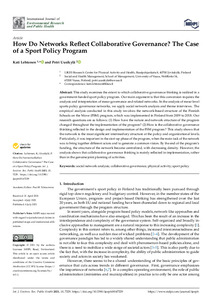How Do Networks Reflect Collaborative Governance? : The Case of a Sport Policy Program
Lehtonen, Kati; Uusikylä, Petri (2021-07-06)
Lehtonen, Kati
Uusikylä, Petri
MDPI
06.07.2021
Julkaisun pysyvä osoite on
https://urn.fi/URN:NBN:fi-fe2021120959944
https://urn.fi/URN:NBN:fi-fe2021120959944
Kuvaus
vertaisarvioitu
© 2021 by the authors. Licensee MDPI, Basel, Switzerland. This article is an open access article distributed under the terms and conditions of the Creative Commons Attribution (CC BY) license (https://creativecommons.org/licenses/by/4.0/).
© 2021 by the authors. Licensee MDPI, Basel, Switzerland. This article is an open access article distributed under the terms and conditions of the Creative Commons Attribution (CC BY) license (https://creativecommons.org/licenses/by/4.0/).
Tiivistelmä
This study examines the extent to which collaborative governance thinking is realized in a government-funded sport policy program. Our main argument is that this conversion requires the analysis and interpretation of meso-governance and related networks. In the analysis of meso-level sports policy governance networks, we apply social network analysis and theme interviews. The empirical analysis conducted in this study involves the network-based structure of the Finnish Schools on the Move (FSM) program, which was implemented in Finland from 2009 to 2018. Our research questions are as follows: (1) How have the nature and network structure of the program changed throughout the implementation of the program? (2) How is the collaborative governance thinking reflected in the design and implementation of the FSM program? This study shows that the network is the most significant intermediary structure at the policy and organizational levels. Particularly, it was important in the start-up phase of the program, when the main task of the network was to bring together different actors and to generate a common vision. By the end of the program’s funding, the structure of the network became centralized, with decreasing density. However, the analysis shows that collaborative governance thinking is mainly reflected in implementation, rather than in the genuine joint planning of activities.
Kokoelmat
- Artikkelit [2621]
